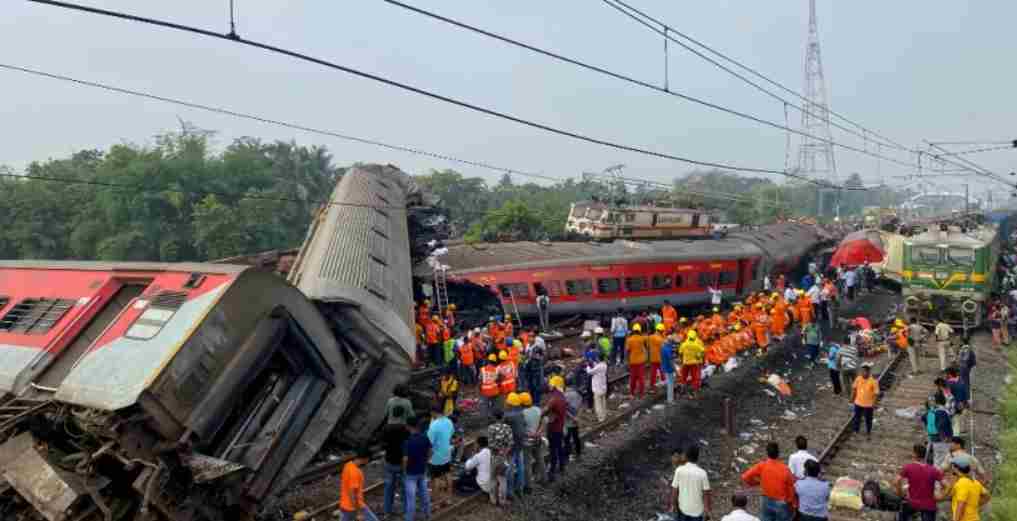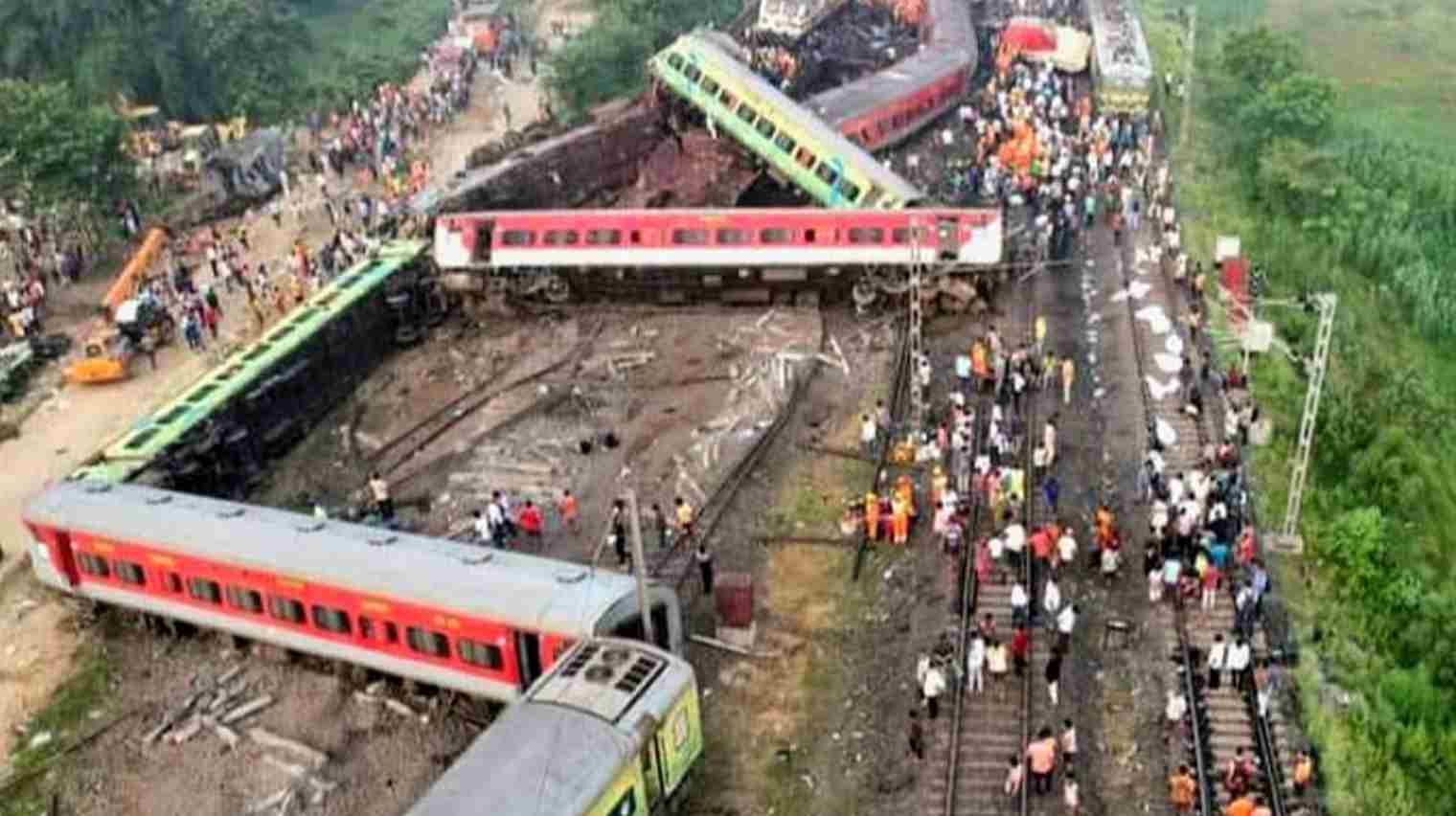Introduction
On 2nd June 2023, a devastating train collision occurred in the Balasore district of Odisha, India. The incident involved three trains – the 12841 Shalimar – MGR Chennai Central Coromandel Express, a goods train, and the 12864 SMVT Bengaluru–Howrah SF Express. This tragic incident resulted in the loss of 288 lives and left 1,175 individuals injured. This tragedy marked the deadliest railway accident in India since the Firozabad rail disaster in 1995 and the deadliest worldwide since the 2004 Sri Lanka tsunami train wreck. The collision raised serious concerns about railway safety and led to a demand for accountability and preventive measures.
The Collision And Its Aftermath

The Coromandel Express, traveling at full speed, mistakenly entered the passing loop instead of the main line near the Bahanaga Bazar railway station. The train collided with a stationary goods train, causing 21 coaches to derail. Shockingly, three of these derailed coaches then collided with the Bengaluru–Howrah SF Express on the adjacent track. The catastrophic impact led to the loss of 288 lives and left 1,175 others injured. The collision resulted in a devastating loss of life, with 288 people losing their lives, primarily in the first three coaches of the Coromandel Express. The injured, numbering 1,175, were rushed to nearby hospitals for medical treatment. The identification of victims proved challenging due to the severity of injuries, with authorities relying on personal belongings to establish their identities. Rescue operations involving various agencies, including the National Disaster Response Force (NDRF), Odisha Disaster Rapid Action Force (ODRF), and local authorities, were initiated immediately.
Investigation And Causes
Preliminary investigations indicated that an error in electronic signals, specifically a change in electronic interlocking, led to the collision. The exact cause of the signal error remains under investigation, with possibilities including wire cuts during excavation or short circuits. The absence of an anti-collision system in the affected section of the track despite prior warnings and shortcomings raised concerns about the railway’s safety measures. The Railways Ministry recommended a Central Bureau of Investigation (CBI) probe to identify the culprits responsible for the incident and to assess systemic failures and safety precautions.
Systemic Failures And Safety Concerns
The collision shed light on long-standing systemic failures and safety concerns within the Indian railway system. It was discovered that the anti-collision system had not been deployed on the track where the collision occurred, despite prior warnings and reports of deficiencies. The Comptroller and Auditor General of India had previously highlighted the lack of adequate staffing in the safety department and the misuse of railway safety funds. These issues, combined with inadequate maintenance and signalling glitches, painted a grim picture of the railway system’s safety measures.
Rescue And Recovery Efforts

In response to the tragedy, extensive rescue operations were launched by various agencies and organizations. The National Disaster Response Force (NDRF), Odisha Disaster Rapid Action Force, fire rescue teams, doctors, police personnel, and ambulances were deployed to the crash site. Local bus companies assisted in transporting the injured, while civilians provided support and assistance to the affected passengers. The recovery process continued throughout the night, with search dogs employed to locate survivors.
The aftermath of the collision resulted in the cancellation, diversion, and termination of numerous train services. Efforts to restore the crash site and repair the affected tracks commenced promptly, and train services resumed after 51 hours of restoration work.
Compensation And Support
Indian Prime Minister Narendra Modi expressed his condolences to the grieving families, while Union Home Minister Amit Shah described the incident as profoundly distressing. Both the Chief Ministers of Odisha and Tamil Nadu declared a day of mourning and offered compensation to the affected families. The Indian Railways announced compensation packages for the victims and their families. A sum of ₹10 lakh (approximately $13,000) was offered to the families of the deceased, ₹2 lakh (approximately $2,500) to the severely injured, and ₹50,000 (approximately $630) to those with minor injuries. The governments of West Bengal and Tamil Nadu also provided additional compensation and support to the affected families.
Political Response And Calls For Accountability
Leaders from India and around the world expressed condolences and offered support to the affected region. However, opposition parties, including the Indian National Congress, Trinamool Congress, Communist Party of India (Marxist), and Communist Party of India, demanded the resignation of Railway Minister Ashwini Vaishnaw and called for a Supreme Court-monitored Special Investigation Team (SIT) inquiry into the accident. They criticized the government for its failure to address the long-standing safety issues within the railway system and for not implementing anti-collision measures.
Investigation And Future Steps
The Central Bureau of Investigation (CBI) initiated an investigation into the accident and visited the crash site to gather evidence. The probe aimed to identify the individuals responsible for the signal error, assess systemic failures, and recommend necessary safety measures to prevent such incidents in the future. Opposition parties also called for a Supreme Court-monitored Special Investigation Team (SIT) inquiry to ensure an impartial investigation.
Conclusion
The train collision in Odisha was a tragic event that claimed the lives of 288 individuals and left over a thousand injured. It revealed deep-rooted flaws in India’s railway safety system, emphasizing the urgent need for comprehensive reforms. The incident called for accountability, thorough investigations, and the implementation of stringent safety measures to prevent similar accidents in the future. As the nation mourned the loss, efforts were underway to restore normalcy and address the issues that contributed to this heart-wrenching catastrophe.
Top 13 Facts About Tragic Train Collision
The train collision occurred on 2nd June 2023 in the Balasore district of Odisha, India.
The accident involved three trains: the 12841 Shalimar – MGR Chennai Central Coromandel Express, a goods train, and the 12864 SMVT Bengaluru–Howrah SF Express.
The Coromandel Express mistakenly entered the passing loop instead of the main line near the Bahanaga Bazar railway station, resulting in a collision with a stationary goods train.
Because of the collision, 21 coaches of the Coromandel Express derailed.
Three derailed coaches from the Coromandel Express collided with the Bengaluru–Howrah SF Express, which was passing on the adjacent track.
The collision led to the tragic loss of 288 lives and left 1,175 others injured.
This accident marked the deadliest railway accident in India since the Firozabad rail disaster in 1995 and the deadliest worldwide since the 2004 Sri Lanka tsunami train wreck.
Preliminary investigations revealed that the Coromandel Express was directed to switch tracks due to an error in electronic signals.
The anti-collision system had not been deployed on the track where the collision occurred, despite prior warnings and reports of deficiencies.
The Comptroller and Auditor General of India had previously highlighted the lack of adequate staffing in the safety department and the misuse of railway safety funds.
Extensive rescue operations were launched by various agencies and organizations, including the NDRF, Odisha Disaster Rapid Action Force, fire rescue teams, doctors, police personnel, and ambulances.
The Indian Railways announced compensation packages for the victims and their families, with amounts ranging from ₹50,000 ($630) for minor injuries to ₹10 lakh ($13,000) for the families of the deceased.
Opposition parties demanded the resignation of Railway Minister Ashwini Vaishnaw, holding the government responsible for failing to address long-standing safety issues and implement anti-collision measures.





